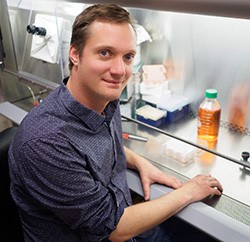Dirk’s work focuses on to establishing reliable techniques that allow modeling of human diseases using genetically engineered human and stem cell and mouse models. As a principle investigator at the University of California Berkeley his team is leveraging their expertise in stem cell biology, mouse genetics and genome editing to elucidate the mechanism stem cell immortality and defects in tissue regeneration. His research team seeks to understand the consequences adult stem depletion syndrome and how this impacts tumor formation, stem cell renewal as well as cellular and organismal aging. We address these questions using genetically engineered human pluripotent stem cells (hPSCs), as well as human adult stem cells, human organoid systems and genetic mouse models.
Co-PI (Core Leadership)
Dirk Hockemeyer, PhD
University of California, Berkeley
Dirk’s work focuses on to establishing reliable techniques that allow modeling of human diseases using genetically engineered human and stem cell and mouse models. As a principle investigator at the University of California Berkeley his team is leveraging their expertise in stem cell biology, mouse genetics and genome editing to elucidate the mechanism stem cell immortality and defects in tissue regeneration. His research team seeks to understand the consequences adult stem depletion syndrome and how this impacts tumor formation, stem cell renewal as well as cellular and organismal aging. We address these questions using genetically engineered human pluripotent stem cells (hPSCs), as well as human adult stem cells, human organoid systems and genetic mouse models.


